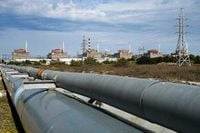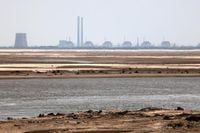Ukraine’s nuclear facilities are once again at the center of global concern after a series of Russian attacks left two of the country’s most sensitive sites—Chornobyl and Zaporizhzhia—without stable external power, raising the specter of a potential nuclear disaster. The situation has drawn urgent warnings from Ukrainian President Volodymyr Zelenskyy and the International Atomic Energy Agency (IAEA), as both plants rely on emergency diesel generators to maintain critical safety systems.
On October 1, 2025, a Russian missile strike targeted an energy substation in Slavutych, the city that provides power to the former Chornobyl Nuclear Power Plant. According to Zelenskyy, the attack unleashed a wave of more than 20 drones, likely Russian-Iranian "Shahed" models, overwhelming Ukrainian defenses and causing a blackout that lasted over three hours. The strike knocked out electricity to critical infrastructure, including the New Safe Confinement—the massive structure that shields the remains of Chornobyl’s destroyed fourth reactor—and facilities storing more than 3,250 tons of highly radioactive spent nuclear fuel.
“The blackout affected critical infrastructure, including the New Safe Confinement, which shields the environment from radioactive debris from the destroyed fourth reactor,” Zelenskyy said, as reported by United24 Media. “It also impacted the storage of spent nuclear fuel, where we keep 80% of all fuel accumulated over the years—more than 3,250 tons of highly radioactive material.”
The loss of power at Chornobyl forced the facility to switch to two emergency diesel generators to keep essential systems running. The IAEA, which operates radiation monitoring systems at the site, warned that blackouts could blind these crucial safeguards, increasing the risk of undetected radioactive releases. The Kyiv Independent quoted a statement noting, “Due to power surges, the New Safe Confinement, the key structure that isolates the destroyed 4th reactor of the Chornobyl Nuclear Power Plant and prevents the release of radioactive materials into the environment, was left without electricity.”
The timing of the Chornobyl incident was especially alarming, coming just eight days after a similar crisis erupted at the Zaporizhzhia Nuclear Power Plant in southern Ukraine. Europe’s largest nuclear facility and one of the ten biggest in the world, Zaporizhzhia has been without external power for more than a week, relying on emergency diesel generators to cool its six shutdown reactors and spent fuel pools. The IAEA confirmed that eight diesel generators are currently running, with nine on standby and three under maintenance, and that fuel reserves are being regularly replenished to allow operation for over ten days.
President Zelenskyy described the situation at Zaporizhzhia as “critical,” emphasizing that the backup systems were never intended to operate for such an extended period. “The generators and the plant were not designed for this,” he said in his nightly address, as cited by the Associated Press. He further warned, “External power, which should operate continuously under normal conditions, has not been restored. Russia is doing nothing to fix the situation. This is a deliberate creation of a nuclear threat.”
IAEA Director-General Rafael Mariano Grossi echoed these concerns, stating, “It is clearly not a sustainable situation in terms of nuclear safety.” He stressed the urgency of restoring external power, adding, “The current status of the reactor units and spent fuel is stable as long as the emergency diesel generators are able to provide sufficient power to maintain essential safety-related functions and cooling.” Grossi said he remains in contact with both Russian and Ukrainian officials, urging a swift reconnection to the power grid.
This marks the tenth time since Russia’s full-scale invasion of Ukraine began on February 24, 2022, that Zaporizhzhia has lost its grid connection. The most recent outage occurred on September 23, when military activity damaged the last functioning power line just 1.5 kilometers from the plant. Control of Zaporizhzhia has been a flashpoint since Russian forces seized it early in the war, and the site has repeatedly found itself in the crossfire.
The Kremlin and Kyiv have traded blame over the latest damage. President Zelenskyy attributes the attacks to Russian artillery, while Kremlin spokesman Dmitry Peskov insists it was Ukrainian shelling. “It is stupid to accuse the Russian side of shelling the plant it controls,” Peskov told reporters, as reported by the BBC.
For Ukrainian officials, the pattern is clear. “Russia could not have been unaware of the consequences for Chornobyl,” Zelenskyy said, highlighting the deliberate nature of the attacks. He has repeatedly called on the international community to take stronger action, warning, “Each day Russia prolongs the war, refuses to fully stop hostilities, and continues striking our energy and nuclear infrastructure, it is creating a global danger.”
The Institute for the Study of War, a Washington-based think tank, argues that Russia’s occupation of Zaporizhzhia has “significantly degraded” the plant’s security. The organization claims Moscow aims to integrate the facility into the Russian grid, a move that would “exacerbate security risks, degrade Ukraine’s future power generation capacity, and serve as a tool that Russia can use to legitimize its occupation of Ukraine.”
Meanwhile, European leaders have been rattled by the growing risks. Recent airspace violations by drones and Russian aircraft have prompted emergency summits in Denmark focused on regional defense and the war’s nuclear dimension. The specter of a nuclear incident, whether caused by direct strikes or loss of power to safety systems, looms large over the continent.
President Zelenskyy has not minced words about what is at stake. “Every day of Russia’s war, every strike on our energy facilities, including those connected to nuclear safety, is a global threat,” he said, criticizing what he called weak responses from the U.N. nuclear watchdog and its chief, Rafael Mariano Grossi. “Weak and half-measures will not work. Strong action is needed.”
Ukraine operates four other nuclear plants, but only Zaporizhzhia remains under Russian occupation. Nevertheless, Zelenskyy warned, “Each of them could be a target for Russian drones or missiles.” He called for “strong, united responses from Europe, the United States, the G7, and G20 to ensure peace and safety. Weak measures will not protect human life.” Expressing gratitude to those who have spoken out, he concluded, “The world cannot remain silent while Russia deliberately endangers nuclear safety.”
As Ukraine’s nuclear plants continue to operate in a precarious balance, relying on backup systems never designed for prolonged use, the stakes could hardly be higher. The risk of a nuclear incident—once thought to be a relic of the Cold War—has returned with alarming immediacy to the heart of Europe’s largest country.


